Mastigotragus
Mastigotragus pyrodes
Richard E. Young and Michael VecchioneIntroduction
Mastigotragus pyrodes is a very distinctive species and the only species of mastigoteuthid known off Southern California, U.S.A.
Brief diagnosis:
A mastigoteuthid ...
- with numerous small but easily seen integumental photophores and a much larger photophore on each eyelid.
- with broad funnel locking-apparatus with strong tragus and without antitragus or undercut posterior margin.
- with comparatively large tentacle-club suckers (about 0.3 mm diam.)
Figure at right. Dorsolateral view of a mastigoteuthid, presumably Mt. pyrodes, off Southern California at 631 m depth with tentacles extended apparently feeding on plankton near the ocean floor. See "Behavior" on the Mastigoteuthidae page. Photograph © 2011 MBARI.
Characteristics
- Arms
- Arms III about 20% longer than arms I and nearly equal in length to arms II.
- Arms III about 20% longer than arms I and nearly equal in length to arms II.
- Tentacles
- Suckers approximately uniform in size on club except near tip.
- Largest suckers of tentacular club about 0.3 mm in longest diameter.
- Suckers approximately uniform in size on club except near tip.
- Head
- Beaks. Description of the beaks can found here in 2D.
- Beaks: Descriptions can be found here in 3D: Lower beak; upper beak.
- Funnel pocket present.
- Funnel
- Funnel locking-apparatus ear-shaped with strong tragus, antitragus virtually absent.
- Posterior border of funnel locking-apparatus not undercut (i. e., does not form a shelf) by oval depression of funnel groove; posterior tip of mantle component does not overlap posterior base (i. e., in profile, the mantle component does not have a hook-shape).
- Fins
- Fin length about 50-60% of ML.
- Fin length about 50-60% of ML.
- Tubercules
- Tubercules absent from the integument except in mature females.
- Tubercules absent from the integument except in mature females.
- Photophores and pigmentation
- Integumental photophores present, large and without obvious covering of vacuolated cells.
- Ringed chromatophores and white spheres absent (present in species of Mastigoteuthis - see that page for direct comparison with Mt. pyrodes).
- Eyelid photophore moderately large (much larger than integumental photophores), oval, present on anteroventral margin of eyelid; may be covered by chromatophores.
- Ocular photophores absent.
- Most pigment in closely-spaced chromatophores.

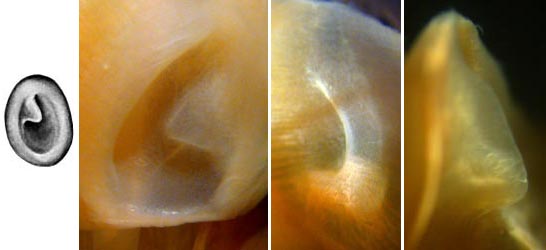
Figure. Funnel/mantle locking-apparatus of Mt. pyrodes. Left - Frontal view of funnel component, holotype. Drawing from Young (1972). Left-center - Frontal view of funnel component, 102 mm ML, immature female, 28°53'N, 118°12'W, preserved, NMNH 727463. Right-center - Frontal view of mantle component, same specimen. Right - Side view of mantle component, same specimen.
Figure. Lateral view of the eyelid photophore of Mt. pyrodes, paratype, NMNH, 73 mm ML, 29°19'N, 119°21'W. Note the relative size of the eyelid photophore compared to the integumental photophores. Photograph by R. Young.
Comments
Additional features of the description can be found here.
Mt. pyrodes has the following unusual features:
- Integumental photophores on the ventral side of the fins as well as dorsal side.
- Funnel component of the funnel/mantle locking-apparatus without an antitragus and without a posterior undercut shelf; mantle component without a hook-nose shape.
- Eyelid photophore much larger than integumental photophores.
- Photophores present on dorsal surfaces of head and mantle, as well as ventral surfaces.
Since the integument and tentacles are often lost during capture, the form of the funnel locking-apparatus is frequently the most useful character in identification.
Mt. pyrodes is easily separated from the Pacific integumental-photophore-bearing Mastigoteuthis dentata by, in addition to the above features, the many (vs. two) series of photophores on arms IV, the large size of the club suckers, and the differences in the integument (abundant chromatophores, lack of ringed chromatophores and white spheres).
Nomenclature
Mastigotragus pyrodes was originally placed in Mastigoteuthis (Young, 1972). The generic revision of the family by Braid, et al. (2014) left, by default, Mt. pyrodes in Mastigoteuthis. Young, et al. (2014) subsequently created a new genus, Mastigotragus, for this species.Life History
Paralarvae are unknown.
Two spent females (145 and 155 mm ML) are known from northern Hawaiian waters. They have a very dark reddish purple color and have rounded tubercules in the integument.

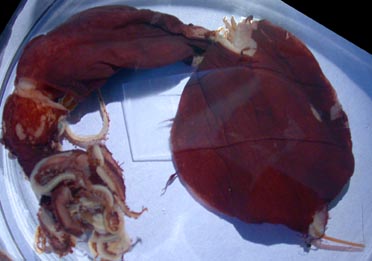
Figure. Dorsal view of Mt. pyrodes, spent female, 145 mm ML, northern Hawaiian waters. Photograph by R. Young.
Skin tubercules are known only in these spent females (mature males are unknown). The rounded tubercules are easily visible under a dissecting microscope. They occur on the mantle, funnel, head and aboral surfaces of the arms as well as the dorsal surface of fins but the latter tubercules appear smaller in size. Integumental photophores remain in the spent females although they are not seen in the photographs below.

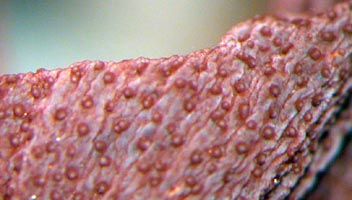
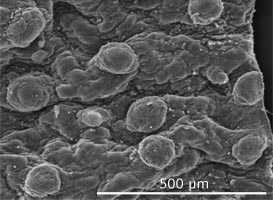
Figure. Mt. pyrodes, 145 mm ML, spent female, northern Hawaiian waters, preserved. Left - External view of a piece of mantle skin, dissecting microscope. Right - Scanning electron micrograph of a similar piece of skin. Photographs by R. Young.
Distribution
Type locality: 33°32'N, 118°23'W, off the coast of Southern California, Eastern North Pacific. Distribution: Off Southern California; northern Hawaiian waters (ca somewhere between 23°N-28°N).
References
Braid, H. E., P. D. McBride, K. S. R. bolstad. 2014. Molecular phylogenetic analysis of the squid family Mastigoteuthidae (Mollusca, Cephalopoda) based on three mitochondrial genes. Hydrobiologia, 725 (1): 145-164.
Young, R. E. 1972. The systematics and areal distribution of pelagic cephalopods from the seas off Southern California. Smithson. Contr. Zool., 97: 1-159.
Young, R. E., M. Vecchione and H.E. Braid. 2014. Mastigotragus, a new generic name for Mastigoteuthis pyrodes Young, 1972 (Cephalopoda: Mastigoteuthidae). European Journal of Taxonomy, No. 105 (2014): 1-6.
Title Illustrations

| Scientific Name | Mastigotragus pyrodes |
|---|---|
| Comments | Holotype |
| Sex | Male |
| Life Cycle Stage | Immature |
| View | Ventral |
| Size | 110 mm ML |
| Image Use |
 This media file is licensed under the Creative Commons Attribution-NonCommercial License - Version 3.0. This media file is licensed under the Creative Commons Attribution-NonCommercial License - Version 3.0.
|
| Copyright |
© 1972

|
About This Page

University of Hawaii, Honolulu, HI, USA

National Museum of Natural History, Washington, D. C. , USA
Page copyright © 2019 and
 Page: Tree of Life
Mastigotragus . Mastigotragus pyrodes .
Authored by
Richard E. Young and Michael Vecchione.
The TEXT of this page is licensed under the
Creative Commons Attribution-NonCommercial License - Version 3.0. Note that images and other media
featured on this page are each governed by their own license, and they may or may not be available
for reuse. Click on an image or a media link to access the media data window, which provides the
relevant licensing information. For the general terms and conditions of ToL material reuse and
redistribution, please see the Tree of Life Copyright
Policies.
Page: Tree of Life
Mastigotragus . Mastigotragus pyrodes .
Authored by
Richard E. Young and Michael Vecchione.
The TEXT of this page is licensed under the
Creative Commons Attribution-NonCommercial License - Version 3.0. Note that images and other media
featured on this page are each governed by their own license, and they may or may not be available
for reuse. Click on an image or a media link to access the media data window, which provides the
relevant licensing information. For the general terms and conditions of ToL material reuse and
redistribution, please see the Tree of Life Copyright
Policies.
- First online 28 February 2004
- Content changed 11 October 2015
Citing this page:
Young, Richard E. and Michael Vecchione. 2015. Mastigotragus . Mastigotragus pyrodes . Version 11 October 2015. http://tolweb.org/Mastigotragus_pyrodes/19523/2015.10.11 in The Tree of Life Web Project, http://tolweb.org/





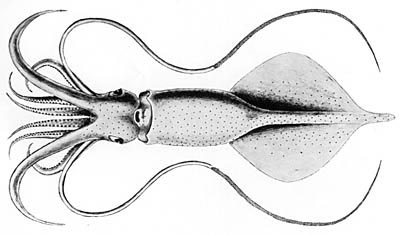

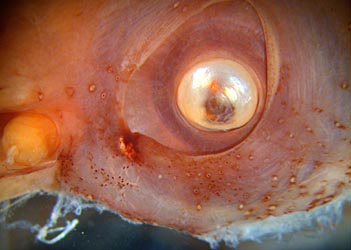



 Go to quick links
Go to quick search
Go to navigation for this section of the ToL site
Go to detailed links for the ToL site
Go to quick links
Go to quick search
Go to navigation for this section of the ToL site
Go to detailed links for the ToL site